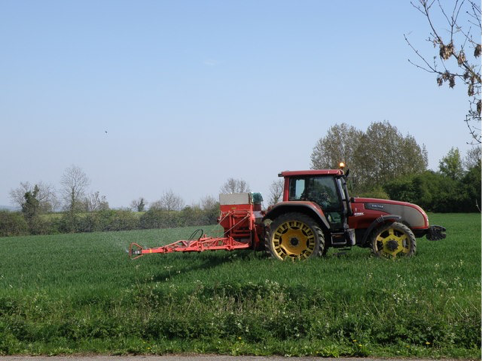Britain's Hidden Nitrogen Addiction

The British Isles are home to a group of farming nations. In the United Kingdom, approximately 77% of the total land area is used for farming, providing a substantial contribution to regional and global food security. Since the mid 19th century, increasing intensification of our agricultural system has led to a hugely important increase in food production, but also a dependency on inputs that is spiralling out of control.
Nitrogen is an essential nutrient for plant growth, and is required in large amounts to sustain this production level. In the UK, approximately 1.375 million tonnes of synthetic nitrogen fertiliser is applied annually, with around 0.5 million tonnes imported from overseas1. It not only travels long distances, but is very energy-intensive to produce (through the Haber-Bosch process), making nitrogen fertiliser the dominant contributor to energy use in British agriculture. These inputs must be reduced because of this energy imbalance, but also as they are environmentally damaging for biodiversity. The relative inefficiency of conventional agricultural systems in retaining nitrogen inputs means that high inputs cause high environmental leakage. In this reactive form, nitrogen causes large-scale changes in the natural nitrogen balance of ecosystems, removing nutrient limitations and changing natural communities. Predominantly though agriculture, we have hijacked natural nitrogen cycling, bringing it firmly into the ‘anthroposphere’.
Organics and the Anthroposphere
Current environmental and agricultural policymakers have hit a conundrum. They strive for ‘sustainable intensification’, as growing populations are increasing food demand while the environment requires a drastic reduction of synthetic nitrogen inputs. Cutting edge research at Oxford is currently looking to engineer crop plants to associate with nitrogen-fixing bacteria and express nitrogenenase, which would enable them to ‘fix nitrogen’. However, Oldroyd et al (2014) suggest that this complex engineering conundrum could be a decade or more away2.
In the absence of technological advancements, how can we achieve sustainable intensification? Organic agriculture has embraced many input-reducing techniques under the guise of environmental sustainability and concerns over health. These include increasing soil-organic-matter through low tillage, intercropping with nitrogen-fixing legumes and more efficient use of green manure (including recycling). However, organic farming methods have been demonstrated to reduce yields by 5-40% over conventional farming in a European context3. A recent meta-analysis of European organics research found that organic farming requires 84% more land because of this yield drop and the necessity to intercrop with legumes4. Although identified as giving valuable contributions to biodiversity conservation and reducing our synthetic nitrogen reliance, the decreasing yield is a threat to achieving sustainable intensification. A better solution has been suggested as taking some of the best nitrogen-conserving approaches in the organic method and applying them to conventional systems, so that highly productive non-organic species and effective pesticides are not shunned to realise higher yields than a completely organic system.
A Question of Scale
Organic methods contribute to solving the ‘sustainability’ aspect of sustainable intensification, but at the cost of yield. On a British scale, the primary concern is environmental, whereas on a global scale the concern is food security. The solution, I believe, lies with the spatial scale in which the problem is defined. Badgley et al (2007) have suggested that if all land in the world currently used for agriculture was converted to an ‘idealised’ organic system with little synthetic nitrogen input, more than enough food to feed the current population could be produced5. Perhaps then, British and European farming could incorporate nitrogen- and biodiversity-conserving traits from the organic system, resulting in lower yields, whereas regions blanketed in low-productivity subsistence agriculture could be encouraged towards higher-yielding and more intensive organic methods. These policy-driven changes would help to limit the damage of unsustainable conventional agricultural expansion. For the British Isles, the pastoral ideal envisaged by conservation organisations would be more attainable, while local food security could be increased for developing nations. These ideas are of course a simplification of a complex problem, as the nutrient requirements and productivity of agriculture are subject to high local heterogeneity, so the most appropriate methods from the ‘organic toolkit’ would need to be implemented through policy at the regional and local scales.
Further Reading
Nitrogen UK, University of Warwick http://www2.warwick.ac.uk/fac/sci/lifesci/wcc/research/nutrition/nmassbal/nitrogenuk.pdf Oldroyd, G.E. & Dixon, R., 2014, Biotechnological solutions to the nitrogen problem, Current opinion in biotechnology, 26, pp. 19-24.
Mondelaers, K., Aertsens, J. & Van Huylenbroeck, G., 2009, A meta-analysis of the differences in environmental impacts between organic and conventional farming, British food journal, 111(10), pp. 1098-119.
Tuomisto, H.L., Hodge, I.D., Riordan, P. & Macdonald, D.W., 2012, Does organic farming reduce environmental impacts?–A meta-analysis of European research, Journal of environmental management, 112, pp. 309-20.
Badgley, C., Moghtader, J., Quintero, E., Zakem, E., Chappell, M.J., Aviles-Vazquez, K., Samulon, A. & Perfecto, I., 2007, Organic agriculture and the global food supply, Renewable agriculture and food systems, 22(2), pp. 86-108.
